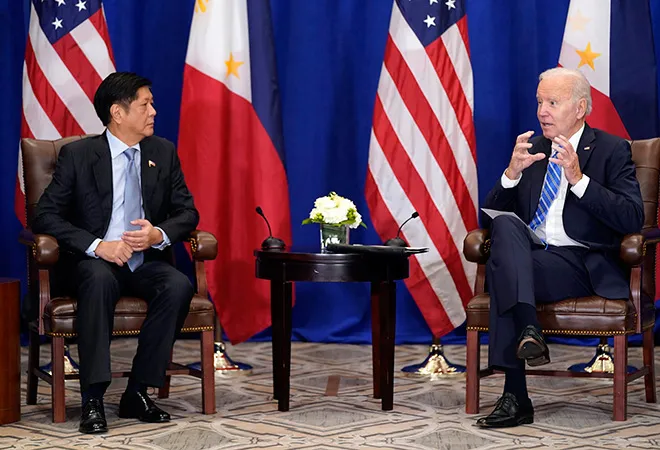
Only four months into the year and 2023 has already been very busy in terms of United States (US) engagement in the Indo-Pacific, particularly in East Asia and the South China Sea. During Philippine President Ferdinand Marcos Jr’s recent visit to the US, alongside reaffirming the continuation of the broader ambit of bilateral partnership, the two countries established ‘ground rules’ on US-Philippine defence cooperation on 3 May. The US and the Philippines have a long-standing treaty partnership that dates back to the post-World War II era. The treaty partnership began with the signing of the Mutual Defense Treaty (MDT) in 1951, which established a framework for military cooperation and mutual defence between the two countries, making Manila the oldest ally of Washington in the region.
The US and the Philippines have a long-standing treaty partnership that dates back to the post-World War II era.
Beijing, quite expectedly, has expressed its disapproval of this new development characterising it as Washington’s attempt at drawing Southeast Asian nations into a
small clique to contain China. Beijing’s usual reaction whenever the US conducts outreach in the region comprises various versions of the narrative that Washington is forcing countries to sacrifice their sovereign identities by becoming pawns in the latter’s efforts to destabilise the region and turn countries against China. Mao Ning, a spokesperson for the Chinese Foreign Ministry stressed that the South China Sea is not a
hunting ground for countries outside of it. Meanwhile, the state-run foreign-language news channel
, CGTN, warned against President Marcos’s ‘
dangerous courtship.’
The reinforced scope of the US-Philippines defence partnership
Interestingly, in addition to reiterating US commitments as Manila’s treaty partner and referencing the strong need for maintaining peace and stability in the South China Sea, the joint statement noted that the two sides “
affirm the importance of maintaining peace and stability across the Taiwan Strait" as an indispensable element of global peace and security. Defence ties between the US and the Philippines have indeed expanded to include, first the South China Sea and now, the Taiwan Strait. What this indicates is a steady consolidation of security frameworks in the region that would form bulwarks against Beijing’s repeated and expanding overtures into the South China Sea and pressures on Taiwan. Given that the Taiwan Strait lies at a distance of only
800 miles from Manila, it is not surprising that the security of the Strait has been included under the expanded purview of Washington and Manila’s treaty partnership.
Under the basic framework of the MDT, the US and the Philippines agreed to come to each other's aid in the event of an attack by an external aggressor. The MDT has been an important part of the US-Philippines relationship, providing a basis for close military cooperation and joint training exercises. The US has provided military aid and assistance to the Philippines, helping to modernise its armed forces and improve its capabilities in areas such as maritime security and counterterrorism.
Beijing’s usual reaction whenever the US conducts outreach in the region comprises various versions of the narrative that Washington is forcing countries to sacrifice their sovereign identities by becoming pawns in the latter’s efforts to destabilise the region and turn countries against China.
Despite episodic friction over issues such as human rights and the rule of law, the US-Philippines treaty partnership remains an important part of both countries' foreign policy agendas. As the geopolitical landscape in Asia continues to evolve, the US-Philippines treaty partnership will likely remain an important pillar of stability and cooperation in the region.
Now, the partnership includes a broadening of “information sharing on the principal threats and challenges” to the peace and security of the US and the Philippines. The upgraded ‘
ironclad’ alliance commitments also make room for the inclusion of new sites which could contribute to the enhancement of Manila’s maritime security and modernisation efforts under the U.S.-Philippines Enhanced Defense Cooperation Agreement. It also creates a greater space for US involvement in the improvement of local and shared capacities in the delivery of humanitarian assistance and disaster relief.
What this means for the Indo-Pacific
President Marcos’s visit comes close on the heels of South Korean President Yoon’s visit to Washington which resulted in the latter agreeing to send an Ohio-class nuclear ballistic missile submarine to Seoul to strengthen deterrence against Pyongyang’s recent nuclear flexing. Earlier in April, Manila allowed Washington access to
four additional military bases for joint training, pre-positioning of equipment and building of facilities such as runways, fuel storage, and military housing. Access to these new locations is significant as two of them—Isabela and Cagayan—are positioned facing Taiwan while the Palawan base is in proximity to the Spratly Islands—a source of a long-standing dispute between China and the Philippines. The two countries have agreed to
resume joint maritime patrols in the South China Sea and Manila is also assessing a
trilateral security pact involving Japan. In mid-April, before President Marcos’s visit, the two countries participated in their largest-ever joint military drills, Exercise Balikatan, in the South China Sea.
The MDT has been an important part of the US-Philippines relationship, providing a basis for close military cooperation and joint training exercises.
China is decidedly furious at the pace and scope of these new developments. Undoubtedly, steps like these are strategic and oriented towards boosting the defence postures of ‘like-minded’ countries in the region. But despite Beijing’s strong censure, these measures are indicative of the breadth and scope of maritime security arrangements in the region being on the course to be further strengthened.
Pratnashree Basu is an Associate Fellow with the CNED programme at ORF
The views expressed above belong to the author(s). ORF research and analyses now available on Telegram! Click here to access our curated content — blogs, longforms and interviews.



 Only four months into the year and 2023 has already been very busy in terms of United States (US) engagement in the Indo-Pacific, particularly in East Asia and the South China Sea. During Philippine President Ferdinand Marcos Jr’s recent visit to the US, alongside reaffirming the continuation of the broader ambit of bilateral partnership, the two countries established ‘ground rules’ on US-Philippine defence cooperation on 3 May. The US and the Philippines have a long-standing treaty partnership that dates back to the post-World War II era. The treaty partnership began with the signing of the Mutual Defense Treaty (MDT) in 1951, which established a framework for military cooperation and mutual defence between the two countries, making Manila the oldest ally of Washington in the region.
Only four months into the year and 2023 has already been very busy in terms of United States (US) engagement in the Indo-Pacific, particularly in East Asia and the South China Sea. During Philippine President Ferdinand Marcos Jr’s recent visit to the US, alongside reaffirming the continuation of the broader ambit of bilateral partnership, the two countries established ‘ground rules’ on US-Philippine defence cooperation on 3 May. The US and the Philippines have a long-standing treaty partnership that dates back to the post-World War II era. The treaty partnership began with the signing of the Mutual Defense Treaty (MDT) in 1951, which established a framework for military cooperation and mutual defence between the two countries, making Manila the oldest ally of Washington in the region.
 PREV
PREV


